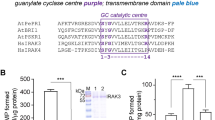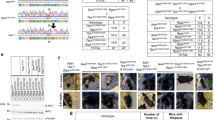Abstract
Inflammation and innate immunity involve signalling pathways leading to the production of inflammatory mediators. Usually such responses are self-limiting, but aberrant resolution of inflammation results in chronic diseases1. Much attention has focused on pro-inflammatory signalling but little is known about the mechanisms that resolve inflammation. The IκB kinase (IKK) complex contains two catalytic subunits, IKKα and IKKβ, and controls the activation of NF-κB transcription factors, which play a pivotal role in inflammation2. Ample evidence indicates that IKKβ mediates NF-κB activation in response to pro-inflammatory cytokines and microbial products. IKKα regulates an alternative pathway important for lymphoid organogenesis2, but the role of IKKα in inflammation is unknown. Here we describe a new role for IKKα in the negative regulation of macrophage activation and inflammation. IKKα contributes to suppression of NF-κB activity by accelerating both the turnover of the NF-κB subunits RelA and c-Rel, and their removal from pro-inflammatory gene promoters. Inactivation of IKKα in mice enhances inflammation and bacterial clearance. Hence, the two IKK catalytic subunits have evolved opposing but complimentary roles needed for the intricate control of inflammation and innate immunity.
This is a preview of subscription content, access via your institution
Access options
Subscribe to this journal
Receive 51 print issues and online access
$199.00 per year
only $3.90 per issue
Buy this article
- Purchase on Springer Link
- Instant access to full article PDF
Prices may be subject to local taxes which are calculated during checkout





Similar content being viewed by others
References
Lawrence, T., Willoughby, D. A. & Gilroy, D. W. Anti-inflammatory lipid mediators and insights into the resolution of inflammation. Nature Rev. Immunol. 2, 787–795 (2002)
Bonizzi, G. & Karin, M. The two NF-κB activation pathways and their role in innate and adaptive immunity. Trends Immunol. 25, 280–288 (2004)
Karin, M. & Ben-Neriah, Y. Phosphorylation meets ubiquitination: the control of NF-κB activity. Annu. Rev. Immunol. 18, 621–663 (2000)
Hoffmann, A., Levchenko, A., Scott, M. L. & Baltimore, D. The IκB-NF-κB signaling module: temporal control and selective gene activation. Science 298, 1241–1245 (2002)
Wertz, I. E. et al. De-ubiquitination and ubiquitin ligase domains of A20 downregulate NF-κB signalling. Nature 430, 694–699 (2004)
Ghosh, S. & Karin, M. Missing pieces in the NF-κB puzzle. Cell 109 (suppl.), S81–S96 (2002)
Makris, C. et al. Female mice heterozygous for IKKγ/NEMO deficiencies develop a dermatopathy similar to the human X-linked disorder incontinentia pigmenti. Mol. Cell 5, 969–979 (2000)
Dejardin, E. et al. The lymphotoxin-beta receptor induces different patterns of gene expression via two NF-κB pathways. Immunity 17, 525–535 (2002)
Senftleben, U. et al. Activation by IKKα of a second, evolutionary conserved, NF-κ B signaling pathway. Science 293, 1495–1499 (2001)
Anest, V. et al. A nucleosomal function for IκB kinase-α in NF-κB-dependent gene expression. Nature 423, 659–663 (2003)
Yamamoto, Y., Verma, U. N., Prajapati, S., Kwak, Y. T. & Gaynor, R. B. Histone H3 phosphorylation by IKK-α is critical for cytokine-induced gene expression. Nature 423, 655–659 (2003)
Liu, G. Y. et al. Sword and shield: Linked group B streptococcal β-hemolysin/cytolysin and carotenoid pigment function to subvert host phagocyte defense. Proc. Natl Acad. Sci. USA 101, 14491–14496 (2004)
Takeuchi, O. et al. Differential roles of TLR2 and TLR4 in recognition of gram-negative and gram-positive bacterial cell wall components. Immunity 11, 443–451 (1999)
Underhill, D. M. et al. The Toll-like receptor 2 is recruited to macrophage phagosomes and discriminates between pathogens. Nature 401, 811–815 (1999)
Bonizzi, G. et al. Activation of IKKα target genes depends on recognition of specific kappaB binding sites by RelB:p52 dimers. EMBO J. 23, 4202–4210 (2004)
Gordon, S. Pattern recognition receptors: doubling up for the innate immune response. Cell 111, 927–930 (2002)
Park, J. M., Greten, F. R., Li, Z. W. & Karin, M. Macrophage apoptosis by anthrax lethal factor through p38 MAP kinase inhibition. Science 297, 2048–2051 (2002)
Puliti, M., von Hunolstein, C., Bistoni, F., Orefici, G. & Tissi, L. Inhibition of nitric oxide synthase exacerbates group B streptococcus sepsis and arthritis in mice. Infect. Immun. 72, 4891–4894 (2004)
Sakurai, H. et al. Tumor necrosis factor-alpha-induced IKK phosphorylation of NF-κB p65 on serine 536 is mediated through the TRAF2, TRAF5, and TAK1 signaling pathway. J. Biol. Chem. 278, 36916–36923 (2003)
Martin, A. G. & Fresno, M. Tumor necrosis factor-alpha activation of NF-κB requires the phosphorylation of Ser-471 in the transactivation domain of c-Rel. J. Biol. Chem. 275, 24383–24391 (2000)
Fognani, C., Rondi, R., Romano, A. & Blasi, F. cRel-TD kinase: a serine/threonine kinase binding in vivo and in vitro c-Rel and phosphorylating its transactivation domain. Oncogene 19, 2224–2232 (2000)
Salghetti, S. E., Muratani, M., Wijnen, H., Futcher, B. & Tansey, W. P. Functional overlap of sequences that activate transcription and signal ubiquitin-mediated proteolysis. Proc. Natl Acad. Sci. USA 97, 3118–3123 (2000)
Perissi, V., Aggarwal, A., Glass, C. K., Rose, D. W. & Rosenfeld, M. G. A corepressor/coactivator exchange complex required for transcriptional activation by nuclear receptors and other regulated transcription factors. Cell 116, 511–526 (2004)
Saccani, S., Marazzi, I., Beg, A. A. & Natoli, G. Degradation of promoter-bound p65/RelA is essential for the prompt termination of the nuclear factor κB response. J. Exp. Med. 200, 107–113 (2004)
Ryo, A. et al. Regulation of NF-κB signaling by Pin1-dependent prolyl isomerization and ubiquitin-mediated proteolysis of p65/RelA. Mol. Cell 12, 1413–1426 (2003)
Chen, E. et al. Degradation of proto-oncoprotein c-Rel by the ubiquitin-proteasome pathway. J. Biol. Chem. 273, 35201–35207 (1998)
Weih, F. et al. Multiorgan inflammation and hematopoietic abnormalities in mice with a targeted disruption of RelB, a member of the NF-κB/Rel family. Cell 80, 331–340 (1995)
Saccani, S., Pantano, S. & Natoli, G. Modulation of NF-κB activity by exchange of dimers. Mol. Cell 11, 1563–1574 (2003)
Sun, S. C., Ganchi, P. A., Ballard, D. W. & Greene, W. C. NF-κB controls expression of inhibitor IκBα: evidence for an inducible autoregulatory pathway. Science 259, 1912–1915 (1993)
Ducut Sigala, J. L. et al. Activation of transcription factor NF-κB requires ELKS, an IκB kinase regulatory subunit. Science 304, 1963–1967 (2004)
Acknowledgements
We thank H. Sakurai, H. Kamata, and G. Fresno for plasmid constructs, and J.M. Park and A. Hoffmann for discussions and advice. T.L. is the recipient of a Wellcome Trust International Research Fellowship. V.N. is an Edward J. Mallinckrodt, Jr Scholar. Research was supported by NIH grants to M.K., who is the Frank and Else Schilling American Cancer Society Research Professor.
Author information
Authors and Affiliations
Corresponding author
Ethics declarations
Competing interests
The authors declare that they have no competing financial interests.
Supplementary information
Supplementary Figure S1
IkkαAA/AA mice exposed to aerosolized LPS showed increased recruitment of neutrophils to the lung which correlated with elevated release of IL-12. (JPG 26 kb)
Supplementary Figure S2
IkkαAA/AA mice showed elevated leukocyte recruitment and chemokine release in response to the TLR2 ligand zymosan. (JPG 11 kb)
Supplementary Figure S3
Macrophages elicited from IkkαAA/AA mice are resistant to GBS0-induced apoptosis and this correlated with elevated production of nitric oxide in vitro. (JPG 29 kb)
Supplementary Figure S4
IKKα mediated C-terminal phosphorylation of RelA and c-Rel in LPS stimulated macrophages. (JPG 21 kb)
Supplementary Figure S5
Termination of NF- B activation in LPS-stimulated macrophages is proteasome dependent. In the presence of a proteasome inhibitor RelA and c-Rel accumulated in the nucleus which correlated with increased recruitment of RelA to the IL-12p40 gene promoter. (JPG 17 kb)
Rights and permissions
About this article
Cite this article
Lawrence, T., Bebien, M., Liu, G. et al. IKKα limits macrophage NF-κB activation and contributes to the resolution of inflammation. Nature 434, 1138–1143 (2005). https://doi.org/10.1038/nature03491
Received:
Accepted:
Issue Date:
DOI: https://doi.org/10.1038/nature03491
This article is cited by
-
Sanziguben polysaccharides inhibit diabetic nephropathy through NF-κB-mediated anti-inflammation
Nutrition & Metabolism (2021)
-
Redox-dependent structural switch and CBF activation confer freezing tolerance in plants
Nature Plants (2021)
-
Islet neogenesis associated protein (INGAP) protects pancreatic β cells from IL-1β and IFNγ-induced apoptosis
Cell Death Discovery (2021)
-
Astragaloside IV Attenuates Polymicrobial Sepsis-Induced Cardiac Dysfunction in Rats via IKK/NF-κB Pathway
Chinese Journal of Integrative Medicine (2021)
-
Peripheral inflammatory biomarkers define biotypes of bipolar depression
Molecular Psychiatry (2021)
Comments
By submitting a comment you agree to abide by our Terms and Community Guidelines. If you find something abusive or that does not comply with our terms or guidelines please flag it as inappropriate.



